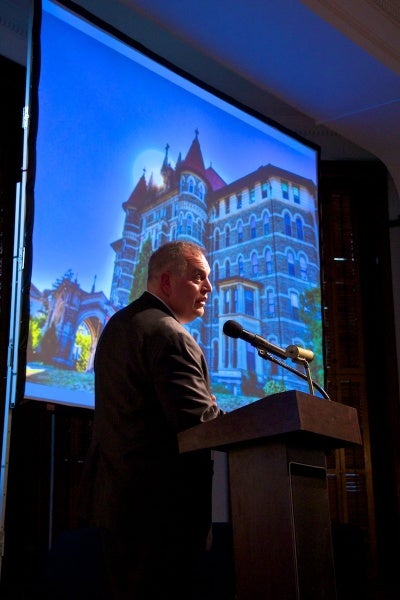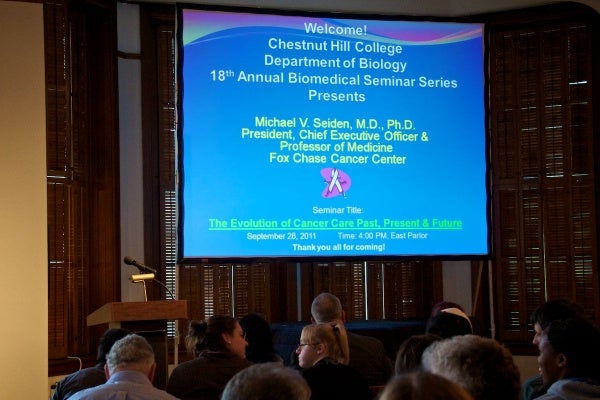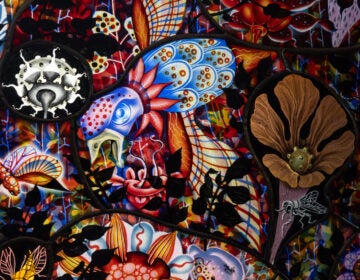Cancer treatments becoming more targeted
The next major challenge in cancer research is how to use advances in DNA sequencing to create personalized treatments, according Dr. Michael Seiden, CEO and president, of Fox Chance Cancer Center. Some patients do better than others with a given treatment and, according to Seiden; this is where personalizing medicine can make a difference.
Seiden made his remarks last Wednesday at Chestnut Hill College’s 18th Annual Biomedical Lecture Series.
In his presentation, titled The Evolution Of Cancer Care Past, Present & Future, Dr. Seiden gave the example of cancer survivor Barbara Bradfield. She was one of the first patients to receive the now commonly prescribed breast cancer drug Herceptin.
Bradfield was the only survivor in that clinical trial. Seiden said it raises the question of why certain therapies work for some and not others.
Another case he cited was the use of the newer technology of chromosome painting to determine gene mutations in cancer patients. He showed the audience an image of tumors from six different women. The tumors had been caused by the most common type of ovarian cancer yet the images clearly illustrated just how genetically distinct each woman’s cancer is.
The Human Genome Project
Dr. Seiden believes that the opportunity for the next generation of cancer research is “to figure out how the decoding of the human genome can be brought to cancer therapy.”
He pointed out that the Human Genome Project was a 13 year effort that was published in 2002, which was followed by “a comprehensive molecular characterization of approximately 100 brain tumors” by the Brain Tumor Consortium just five years later, and only 2 years after that saw publication of 300 ovarian cancer sequences.
“Think about that. 200,000 years of humanity… The first 197,000 years we didn’t even know cancer existed. Now we’re knocking off whole genomes of thousands of tumors a year!” Seiden enthused to a rapt audience. He predicted that within 5 years people will be able to have their genome sequence at a cost of a few hundred dollars and ready within days and stated, “This fantastic technology will be at everyone’s fingertips much sooner than we think.” From the Ion Torrent machine for sequencing genomes, which today costs a few hundred thousand dollars and can fit on a desktop, to Fox Chase’s year old Cancer Genome Institute, “The ability to do deep dives into genetics is right around the corner,” announced Seiden.
The early milestones
To fully appreciate the advances that have been made over just the past few decades, Seiden said for most of human history very little was known about cancer.
The earliest known description of cancer occurred circa 2600 B.C., around 150 A.D. an erroneous theory emerged that cancer was caused by excessive black bile, but the bile theory was disproved 14 centuries later during the time of the Renaissance. However, it was not until the 1800s that surgery became a recognized effective tool to treat cancer.
Seiden gave an anecdotal account of Ephraim McDowell, the first surgeon in the world to perform ovarian cancer surgery in 1809 from a woman who went on to live another 32 years. Surgery continues to be an important tool though it now “is driven by technologies of molecular energies, robotics,” Seiden explained.
It was the Nobel Prize winning work of Marie Curie at the turn of the 20th century that enabled the development of the next important cancer treatment tool: radiation therapy, noted Dr. Seiden. A half century later, Dr. Henry Kaplan pioneered this new therapy with the invention of the first medical linear accelerator.
Around the same time, researchers developed the first chemotherapy, which Seiden admitted derives from a “ghastly history” – chemical warfare, specifically nitrogen mustard gas, which was extensively utilized in WWI. During the next few decades, scientists began to synthesize chemicals, which, as Seiden explained, “led to the modern pharmacology that underpins oncology that guided researchers in the past few decades.”
The technology revolution
Dr. Seiden said that the future of cancer research “is a field that is going to require a much smarter group than my generation to solve. There will be an absolutely unusual set of tools available to all of you in the next twenty years to make a big difference.” To illustrate the rapid changes the technology is undergoing, he closed his lecture with the “Did You Know? Shift Happens” and was created by Karl Fisch and Scott McLeod, and has since gone viral on YouTube.
WHYY is your source for fact-based, in-depth journalism and information. As a nonprofit organization, we rely on financial support from readers like you. Please give today.












